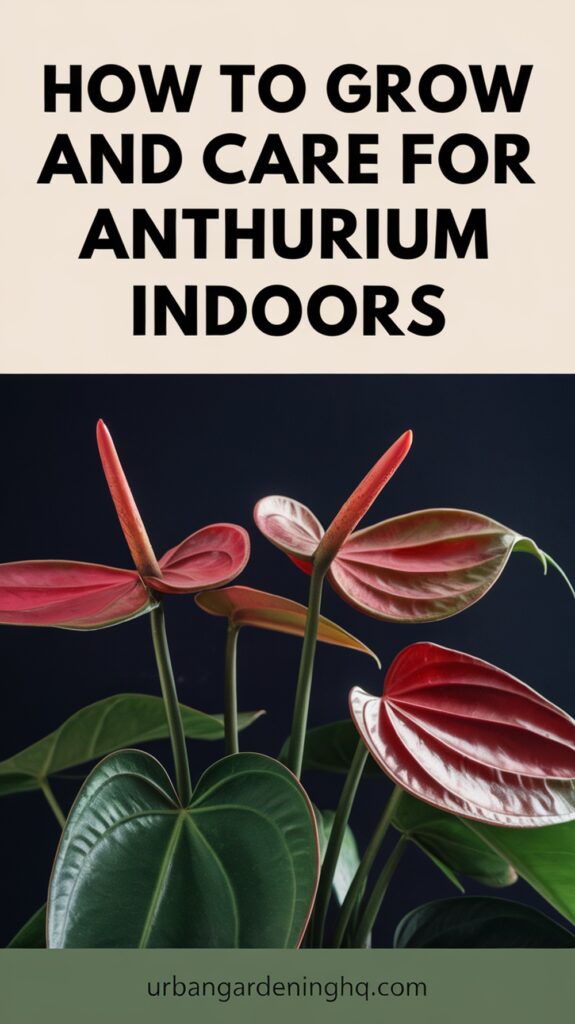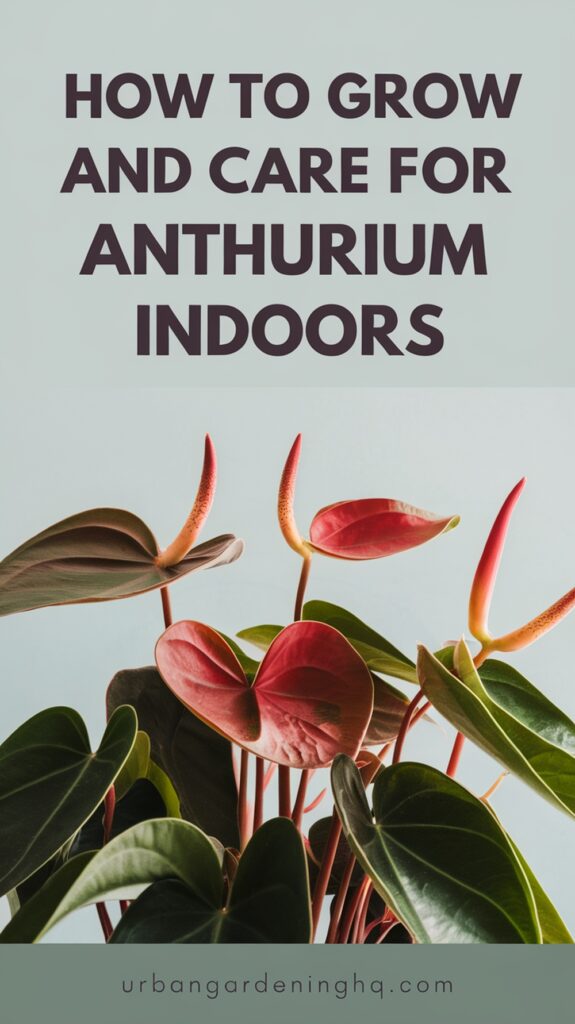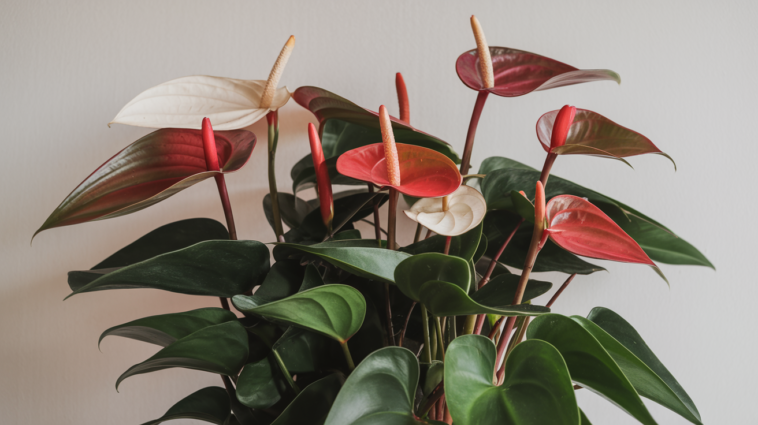I’m excited to introduce you to the Anthurium, a stunning tropical flower perfect for indoor plants. Its unique beauty and versatility make it a favorite among gardeners in the United States.
As I explore this incredible tropical flower, I’ll share why it’s great for indoor plants. It adds elegance to any room. This article is for both seasoned gardeners and beginners. It covers Anthurium’s origins, care, and uses in decoration, making it a great indoor plant addition.
The Fascinating World of Anthurium Plants

Exploring Anthurium, I find its rich history and cultural importance striking. This plant comes from the tropical areas of Central and South America. For centuries, it has been a symbol of hospitality and friendship in many cultures.
The origins of Anthurium are deeply tied to tropical plants. It grows well in the warm, humid climates of its natural home.
Anthurium’s cultural value goes beyond its beauty. It’s seen as a symbol of love, friendship, and hospitality. This makes it a favorite for gifts and decorations. As indoor plants, Anthuriums purify the air and make spaces welcoming.
Some key benefits of having Anthurium as indoor plants include:
- Purifying the air and improving air quality
- Creating a welcoming and calming atmosphere
- Adding a touch of natural beauty to any room
There’s more to Anthurium than its origins and cultural value. Its stunning flowers and lush leaves make it a favorite among plant lovers. Whether you want to add tropical flair or explore indoor plants, Anthurium is a great choice.
Physical Characteristics of the Anthurium
Exploring the Anthurium reveals its unique features. Its heart-shaped leaves and long, tail-like flowers make it stand out. Knowing these traits helps in caring for your Anthurium, making it a stunning houseplant.
Some key features of the Anthurium include:
- Heart-shaped leaves with a glossy texture, adding tropical elegance to any room
- Long, tail-like flowers in colors like pink, red, and white, perfect for floral arrangements
- A compact growth habit, ideal for indoor spaces like apartments or offices
The Anthurium thrives in warm, humid environments. This makes it perfect for adding a tropical feel to your home. Understanding its physical characteristics ensures your plant stays healthy and beautiful.
| Characteristics | Description |
|---|---|
| Leaf Shape | Heart-shaped |
| Flower Shape | Long, tail-like |
| Growth Habit | Compact |
Popular Anthurium Varieties to Consider
Exploring Anthuriums opens up a world of elegance for any space. With over 1,000 species, finding the right one is key. Whether you’re new or experienced, there’s an Anthurium for everyone.
Anthurium varieties like Anthurium Andraeanum are perfect for vibrant flowers. For unique leaves, try Anthurium Crystallinum. Other favorites include Anthurium Clarinervium and Anthurium Veitchii, each with its own needs.
Anthurium Andraeanum
Anthurium Andraeanum is loved for its bright, lasting flowers. It blooms for months with the right care. It’s great for indoor gardens.
Anthurium Crystallinum
Anthurium Crystallinum stands out with its crystalline leaves. It needs high humidity and moderate light to thrive. Following these tips keeps it happy and healthy.
Essential Growing Conditions for Thriving Anthuriums

To create the perfect home for your Anthurium, it’s key to mimic its natural habitat. As someone who loves indoor gardening, focus on the right conditions. This includes humidity, temperature, and light. Anthuriums love bright, indirect light, making them great for sunny rooms.
Temperature-wise, Anthuriums do best between 65-75 degrees Fahrenheit. This makes them perfect for indoor spots, as they handle room temperatures well. To keep your Anthurium moist, aim for 50-70% humidity. You can use a tray with water and pebbles or a humidifier to get there.
For the best flower care, remember these tips:
- Watering: Let the soil dry a bit before watering to avoid root rot.
- Lighting: Bright, indirect light helps with growth and blooms.
- Humidity: Keep it humid to match the plant’s natural home.
By following these tips and giving your Anthurium the right care, you’ll enjoy its stunning flowers and leaves. With the right attention, your Anthurium will flourish, adding beauty to your indoor garden.
Mastering Anthurium Care Requirements
To keep your Anthurium thriving, it’s key to know its specific needs. The right amount of water, light, and nutrients are vital for its growth. When watering, it’s safer to be cautious to avoid root rot from too much water and yellow leaves from too little.
Checking the soil moisture by sticking your finger into the soil up to the first knuckle is a good way to know when to water.
Anthuriums need bright, indirect light to photosynthesize and bloom. A spot near an east- or west-facing window is perfect. They also prefer a humid environment, between 50-70% relative humidity. You can boost the humidity by placing the plant on a tray with water and pebbles or using a humidifier.
Fertilizing your Anthurium is also important. Use a balanced, water-soluble fertilizer during the growing season (spring and summer). Dilute it to half the recommended strength to prevent root damage. Here are some tips to keep in mind:
- Water your Anthurium carefully, avoiding getting water on the leaves or crown to prevent rot.
- Provide bright, indirect light, but avoid direct sunlight, which can cause leaf scorch.
- Maintain a humid environment, but ensure good air circulation to prevent fungal diseases.
- Fertilize your plant regularly, but avoid overfertilizing, which can damage the roots and leaves.
By following these tips and understanding your Anthurium’s needs, you’ll become an expert in Anthurium care. Enjoy the beauty of these stunning plants.
Propagation Methods for Your Anthurium

Exploring Anthurium propagation is exciting. I’m here to share how to multiply these beautiful plants. Whether you’re new to gardening or have experience, it’s a fun and rewarding task. You can share plants with friends or grow your collection.
Division is a common method. It involves separating a mature plant’s roots to create new ones. This is simple: just gently separate the roots and replant them. Stem cutting is another popular way. It involves taking parts of the plant and rooting them in a medium. For more details, check out this Anthurium propagation guide.
Techniques for Successful Propagation
- Division: separate the roots of a mature plant to create new individuals
- Stem cutting: take cuttings from the plant and root them in a suitable medium
- Seeds: though less common, seed propagation is exciting for adventurous gardeners
By using these techniques and the right materials, you can successfully propagate your Anthurium. Enjoy these plants for years. Whether you choose division, stem cutting, or seeds, it’s a great way to share your love of plants.
Troubleshooting Common Anthurium Problems
As a houseplant lover, I’ve found that even with the best care, Anthuriums can face challenges. Solving these problems needs careful observation and knowing what your plant needs. Issues like pests, diseases, and nutrient shortages can be fixed by changing how you care for it. Sometimes, using organic pest control is needed.
Problems like spider mites, mealybugs, and root rot are common. To avoid these, keep a close eye on your plant’s health. Use a balanced fertilizer to help it grow well and avoid nutrient gaps. Regular pruning and repotting can also stop root rot and other issues.
Spotting problems early is key to fixing them. Here are some signs of trouble with Anthuriums:
- Yellowing or droopy leaves
- White, cottony patches on the leaves or stems
- Soft, mushy roots
By noticing these signs and acting fast, you can stop many problems. This way, your Anthurium will stay healthy and beautiful. With the right care, your indoor plants will thrive, and you’ll enjoy your Anthuriums for many years.
Decorating with Anthuriums: Style and Display Tips

Decorating with Anthuriums opens up a world of style options. Their vibrant flowers and unique leaves can make any room elegant. To make a stunning display, mix Anthuriums with plants that have different textures and colors.
Here are some display tips to keep in mind:
- Choose a planter that complements the color and style of your Anthurium
- Experiment with different heights and angles to add visual interest
- Consider the lighting in the room and place your Anthuriums where they’ll look best
Some great plants to pair with Anthuriums are ferns, peace lilies, and bromeliads. These plants, when combined with Anthuriums, create a unique display that shows off your style. Whether you want to add a tropical vibe or a splash of color, Anthuriums are a fantastic choice.
| Plant | Description | Pairing Tips |
|---|---|---|
| Anthurium | Vibrant flowers and unique foliage | Pairs well with ferns and peace lilies |
| Ferns | Delicate texture and lush green color | Complements Anthuriums with contrasting textures |
| Peace Lilies | Elegant white blooms and dark green leaves | Creates a striking contrast with Anthuriums’ bright colors |
Seasonal Care and Maintenance Guide
Exploring Anthurium care, I’ve learned the value of seasonal adjustments. Plant care techniques, like seasonal care, are key to keeping my Anthurium healthy and stunning. In spring and summer, my Anthurium needs more water and food because it’s growing fast.
To give my Anthurium the best care, I adjust watering and light. Important seasonal care tips include:
- Adjusting the watering schedule to match the plant’s growth cycle
- Providing enough light, but not direct sunlight
- Fertilizing often with a balanced fertilizer
By using these tips, my Anthurium stays vibrant and lovely all year. As seasons shift, I must pay attention to my Anthurium’s needs. This way, I can give it the best care and keep it thriving.
Conclusion: Embracing the Beauty of Your Anthurium Journey

Reflecting on our journey with Anthuriums, I feel deep gratitude for these tropical wonders. Their bright, heart-shaped flowers and easy care make them a joy for all. They are a true delight for gardeners and plant lovers.
Starting or continuing your Anthurium journey brings nature’s magic into your home. These plants thrive indoors, making them great companions. They add a touch of the outdoors to your space.
As you care for your Anthurium, take time to admire its strength and cultural importance. Find ways to show off its beauty. This will not only bring you vibrant blooms but also a closer bond with nature.


